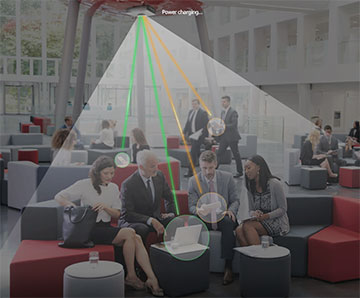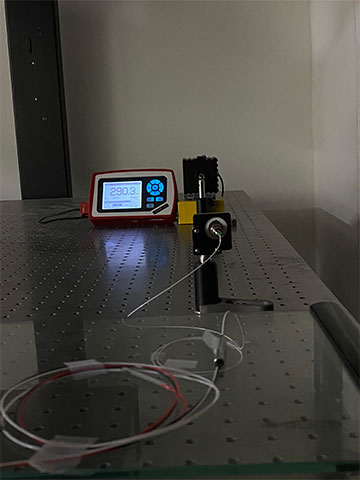
Researchers created a new wireless charging system that uses infrared light to more safely transfer optical power across distances of up to 30 m. [Image: J. Ha, Sejong University]
How nice would it be to charge electronics without having to carry around a tangle of power cables and plugs? Researchers from Sejong University, Republic of Korea, aim to make this dream a reality with a novel approach to safer and more efficient wireless optical charging (Opt. Express, doi: 10.1364/OE.468766).
Unlike previous designs, the new system uses a distributed laser charging method to provide a high-power infrared signal with less loss at greater distances. In proof-of-concept demonstrations, the system transferred 400 mW of optical power to a receiver 30 m away. While the resulting 85 mW of electrical power is not enough to charge a phone, the researchers plan to optimize the design to achieve higher energy efficiency.
In addition to charging smartphones and other personal electronics, the wireless charging system “could also power various sensors such as those in Internet of Things devices and sensors used for monitoring processes in manufacturing plants,” research team leader Jinyong Ha said in a press release.
Prototype design
Current techniques being considered for wireless optical power transfer are limited by short transfer distances (up to 5 m), bulky and expensive equipment, and unsafe energy levels that can damage eyes and skin. Ha and his colleagues addressed these design challenges by optimizing a distributed laser charging method to create a prototype that is safe and can operate over a long distance.
A distributed laser charging system includes separate transmitter and receiver elements, rather than housing all elements together in a single device. When the distributed laser’s transmitter and receiver are aligned, a laser cavity forms in the space between them that transfers light (and, thus, optical power) from one location to another. The setup allows for sending optical signals over longer distances with less loss than traditional laser designs and can be used with safer infrared wavelengths of light.

The system includes a transmitter with an erbium-doped fiber amplifier power source and a receiver with a ball-lens retroreflector that helps boost performance and safety. [Image: J. Ha, Sejong University]
The researchers built their wireless optical-power transfer system with an erbium-doped fiber amplifier, which emits light with a 1550-nm central wavelength, as the transmitter and power source. They used a spherical-lens retroreflector (n = 2.003) as the receiver element. The ball lens gives the design a very flexible 360-degree transmitter-receiver alignment and maximizes power-transfer efficiency.
To make the system safer to use around people, the researchers deployed a wavelength division multiplexing filter to the transmitter signal to get a 1550-nm narrowband beam for illuminating the receiver. The ball lens reflects part of the narrowband beam back to the transmitter, creating a closed-ring resonance loop. If the beam is interrupted by an object or a person, the resonance is terminated, reducing the 1 W incident power to 0.79 mW—well within the maximum permissible exposure standards.
Wirelessly powering an LED
To test their prototype, the researchers placed the system’s receiver 30 m away from the transmitter. The receiver element included a photovoltaic cell to convert the transmitter’s optical signal to electricity, which powers an attached LED.
Demonstrations showed that the prototype transferred 400 mW of optical power with a channel linewidth of 1 nm to the receiver 30 m away. The photovoltaic cell within the receiver converted the optical power into 85 mW of electricity for the LED. The researchers also showed that the system’s power-safe mode functioned as expected when the optical signal was blocked by a team member’s hand.
In future iterations, the researchers plan to increase the system’s power and range, as well as improve photovoltaic-cell efficiency. They are also developing a method for using their system to charge multiple receivers at the same time.
